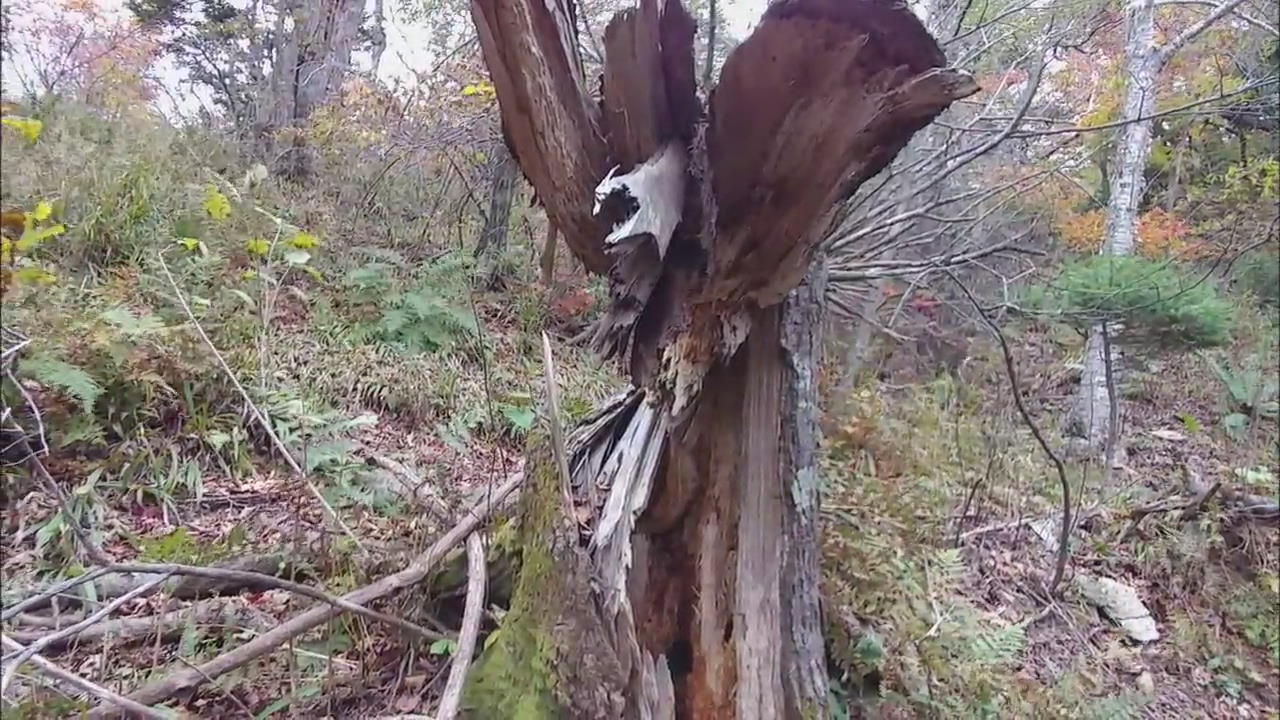Climate Change
입력 2019.04.05 (15:31)
수정 2019.04.05 (16:20)
읽어주기 기능은 크롬기반의
브라우저에서만 사용하실 수 있습니다.
[Anchor Lead]
Climate change has completely transformed the ecological environment of forests in the Korean Peninsula. Coniferous trees in Hallasan and Jirisan Mountains and other high altitude regions are dying in droves from so-called "water stress."
[Pkg]
This is Balwangsan Mountain in Pyeongchang, Gangwon-do Province. Blackened trees are spotted on the summit at 1,458 meters above sea level. Khingan fir trees, an evergreen coniferous species of fir.
[Soundbite] (Green Union Inspector) : "The branches are snapping off, because they're already dead."
Water shortage is the cause of this problem. Trees absorb moisture from the winter snow and retain it until late spring. But the declining snowfall has caused the trees to suffer so-called "water stress." Some of the desiccated trees have been uprooted and have fallen over sideways. These trees are mostly taller than 10 meters and more than 20 or 30 years old. The largest colony of Korean fir trees found only in Korea is located in Hallasan Mountain. Patches of gray, dried trees are spotted here and there. Coniferous trees near Banyabong Peak of Jirisan Mountain have also died from dehydration. Dead trees have caused a mud slide here. An increasingly warmer Korean Peninsula and the subsequent dehydration in the high mountain areas are serious threats to the ecological system of coniferous trees in the nation.
[Soundbite] Seo Jae-cheol(Expert Adviser, Green Union) : "Coniferous trees may disappear from the mountainous areas around the Baekdudaegan Mountain Range in the next 10 or 20 years."
Experts say the coniferous tree withering situation should be accurately assessed and the endangered Korean fir trees should be placed under special supervision.
Climate change has completely transformed the ecological environment of forests in the Korean Peninsula. Coniferous trees in Hallasan and Jirisan Mountains and other high altitude regions are dying in droves from so-called "water stress."
[Pkg]
This is Balwangsan Mountain in Pyeongchang, Gangwon-do Province. Blackened trees are spotted on the summit at 1,458 meters above sea level. Khingan fir trees, an evergreen coniferous species of fir.
[Soundbite] (Green Union Inspector) : "The branches are snapping off, because they're already dead."
Water shortage is the cause of this problem. Trees absorb moisture from the winter snow and retain it until late spring. But the declining snowfall has caused the trees to suffer so-called "water stress." Some of the desiccated trees have been uprooted and have fallen over sideways. These trees are mostly taller than 10 meters and more than 20 or 30 years old. The largest colony of Korean fir trees found only in Korea is located in Hallasan Mountain. Patches of gray, dried trees are spotted here and there. Coniferous trees near Banyabong Peak of Jirisan Mountain have also died from dehydration. Dead trees have caused a mud slide here. An increasingly warmer Korean Peninsula and the subsequent dehydration in the high mountain areas are serious threats to the ecological system of coniferous trees in the nation.
[Soundbite] Seo Jae-cheol(Expert Adviser, Green Union) : "Coniferous trees may disappear from the mountainous areas around the Baekdudaegan Mountain Range in the next 10 or 20 years."
Experts say the coniferous tree withering situation should be accurately assessed and the endangered Korean fir trees should be placed under special supervision.
■ 제보하기
▷ 카카오톡 : 'KBS제보' 검색, 채널 추가
▷ 전화 : 02-781-1234, 4444
▷ 이메일 : kbs1234@kbs.co.kr
▷ 유튜브, 네이버, 카카오에서도 KBS뉴스를 구독해주세요!
- Climate Change
-
- 입력 2019-04-05 15:34:17
- 수정2019-04-05 16:20:26

[Anchor Lead]
Climate change has completely transformed the ecological environment of forests in the Korean Peninsula. Coniferous trees in Hallasan and Jirisan Mountains and other high altitude regions are dying in droves from so-called "water stress."
[Pkg]
This is Balwangsan Mountain in Pyeongchang, Gangwon-do Province. Blackened trees are spotted on the summit at 1,458 meters above sea level. Khingan fir trees, an evergreen coniferous species of fir.
[Soundbite] (Green Union Inspector) : "The branches are snapping off, because they're already dead."
Water shortage is the cause of this problem. Trees absorb moisture from the winter snow and retain it until late spring. But the declining snowfall has caused the trees to suffer so-called "water stress." Some of the desiccated trees have been uprooted and have fallen over sideways. These trees are mostly taller than 10 meters and more than 20 or 30 years old. The largest colony of Korean fir trees found only in Korea is located in Hallasan Mountain. Patches of gray, dried trees are spotted here and there. Coniferous trees near Banyabong Peak of Jirisan Mountain have also died from dehydration. Dead trees have caused a mud slide here. An increasingly warmer Korean Peninsula and the subsequent dehydration in the high mountain areas are serious threats to the ecological system of coniferous trees in the nation.
[Soundbite] Seo Jae-cheol(Expert Adviser, Green Union) : "Coniferous trees may disappear from the mountainous areas around the Baekdudaegan Mountain Range in the next 10 or 20 years."
Experts say the coniferous tree withering situation should be accurately assessed and the endangered Korean fir trees should be placed under special supervision.
Climate change has completely transformed the ecological environment of forests in the Korean Peninsula. Coniferous trees in Hallasan and Jirisan Mountains and other high altitude regions are dying in droves from so-called "water stress."
[Pkg]
This is Balwangsan Mountain in Pyeongchang, Gangwon-do Province. Blackened trees are spotted on the summit at 1,458 meters above sea level. Khingan fir trees, an evergreen coniferous species of fir.
[Soundbite] (Green Union Inspector) : "The branches are snapping off, because they're already dead."
Water shortage is the cause of this problem. Trees absorb moisture from the winter snow and retain it until late spring. But the declining snowfall has caused the trees to suffer so-called "water stress." Some of the desiccated trees have been uprooted and have fallen over sideways. These trees are mostly taller than 10 meters and more than 20 or 30 years old. The largest colony of Korean fir trees found only in Korea is located in Hallasan Mountain. Patches of gray, dried trees are spotted here and there. Coniferous trees near Banyabong Peak of Jirisan Mountain have also died from dehydration. Dead trees have caused a mud slide here. An increasingly warmer Korean Peninsula and the subsequent dehydration in the high mountain areas are serious threats to the ecological system of coniferous trees in the nation.
[Soundbite] Seo Jae-cheol(Expert Adviser, Green Union) : "Coniferous trees may disappear from the mountainous areas around the Baekdudaegan Mountain Range in the next 10 or 20 years."
Experts say the coniferous tree withering situation should be accurately assessed and the endangered Korean fir trees should be placed under special supervision.
이 기사가 좋으셨다면
-
좋아요
0
-
응원해요
0
-
후속 원해요
0














![[단독] 골프연습장 아니라더니<br>…‘한남동 골프연습장’ 도면 입수](/data/news/2025/07/01/20250701_Uh8Jnu.png)


이 기사에 대한 의견을 남겨주세요.